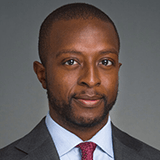March 12, 2024
Law and the Movement for Reparations
Director of Policy and Program for Racial Justice

This article first appeared in print in Reparations Daily(ish) Volume 102
When you think about slavery, Jim Crow, and other forms of anti-Black oppression, a few familiar villains probably come to mind—you might think of brutal overseers whipping Black people on plantations, cruel auctioneers ripping families apart, or sadistic police setting dogs on Black protesters. You probably don’t immediately think about the thousands of lawyers who worked behind the scenes to normalize these atrocities, including lawmakers, judges, prosecutors, and private attorneys.
Yet, from the Constitution, which initially counted enslaved people as three-fifths of a person, to the Supreme Court’s doctrine of “separate but equal,” to contracts legitimizing the sale of human beings, the law and lawyers have played a central role in the dehumanization of Black people. Because of this history, lawyers and the law have a unique role to play in the struggle for racial justice and repair.
In New York, the movement to address anti-Black oppression led to the abolition of slavery in 1827 in the state, but that laudable effort did not disentangle New York from the exploitation of Black bodies. Until the Civil War, New York-based banks like JP Morgan accepted enslaved people as collateral for loans, and insurance firms like New York Life offered policies insuring enslavers for loss of enslaved “property.” Locally, Black communities were devastated by anti-Black race riots in 1863, 1900, and 1919—mass atrocities that went largely unprosecuted. And practices like redlining continued to diminish the value of Black property and Black life well into the 20th century.
Today, as a result of these and similar accumulated injustices, the median white New York household has nearly 15 times as much wealth as the median Black household, a wealth gap 50% greater than the national average. And Black New Yorkers continue to face worse life outcomes in almost every category, from education, to health, to the criminal legal system.
To address the magnitude of this harm, the movement for reparations draws upon familiar legal principles. Just as plaintiffs who have suffered harms like battery, assault, false imprisonment, conversion, and unjust enrichment can bring civil claims to have their harms acknowledged and be made whole, reparations processes offer an opportunity to assess and respond to collective harms and injustices. And while a verdict or money judgment, or reparations process can never fully compensate for past harm, it is a meaningful step toward justice.
As the reparations process begins in New York, the first step will be establishing a comprehensive and accurate record of what occurred. Through historical documents, statistical evidence, and witness testimony, reparations commissions can reconstruct a comprehensive understanding of the past—and how it is connected to the present. One promising recent example of this work is the mammoth report of the California Reparations Task Force, which details the history of anti-Black oppression in that state and its ongoing ramifications for housing, education, political representation, the environment and other fields.
The second, and often more contentious work of reparations is to design remedies, but here as well, reference to “traditional” legal principles is informative. Civil law operates on the principle of placing plaintiffs in the position they would have been in if the harm had not occurred. While we know that this is functionally impossible or very difficult, it is a useful north star. Reparations activists suggest that we should look to see what it would take to achieve realized equality in our society by leveling the racial wealth gap and eliminating racial inequities in health, housing, education and other life outcomes.
History offers several models for direct payments to the victims of past harms and their descendants, including German payments to survivors of the Holocaust, payments authorized by Congress for victims of the interment of Japanese Americans during World War II, scholarships designated for survivors of the Rosewood massacre in Florida, and housing assistance to survivors of housing discrimination in Evanston, Illinois. While it is likely that only the federal government is sufficiently resourced to meet the total cost of reparations for slavery, state and local efforts play a critical role in building momentum and creating the factual record necessary for a national undertaking.
As in the past, lawyers may present some of the biggest obstacles to justice. Conservative legal operatives like Edward Blum, a key figure in the push to dismantle affirmative action, DEI, and voting rights, has signaled his opposition to reparations efforts and sent threatening letters to the Evanston commission in an attempt to derail that effort.
Thankfully, so far, federal courts have refused to strike down reparations efforts, describing the government’s interest in remedying past discrimination by state actors as “unquestionably” compelling, particularly when those acts are well documented and the proposed remedies for those acts are narrowly tailored to address the harm committed. Now, as in the past, it is crucial to develop the robust factual record that will be necessary to support bold action to eliminate racial disparities.
Despite opposition from the likes of Blum, the reparations movement continues to grow. In New York, lawyers in particular, have an opportunity to weigh in on the right side of history, reckon with the past's harms, and help chart a brighter future.
_________________________
 Taonga Leslie is the Director of Policy and Program for Racial Justice at ACS.
Taonga Leslie is the Director of Policy and Program for Racial Justice at ACS.
Equality and Liberty, Racial Justice, Truth, Racial Healing, & Transformation




